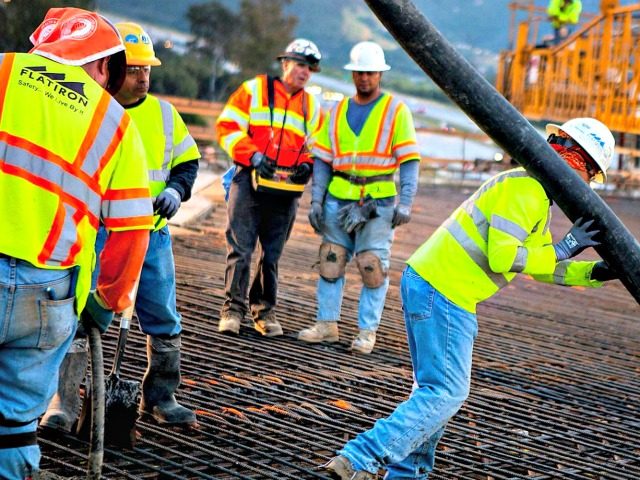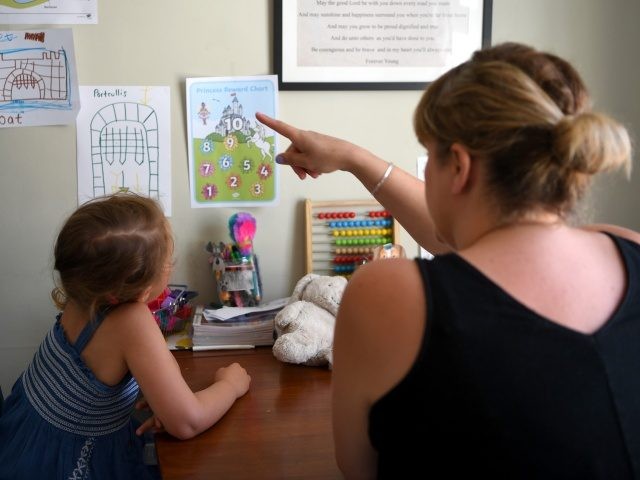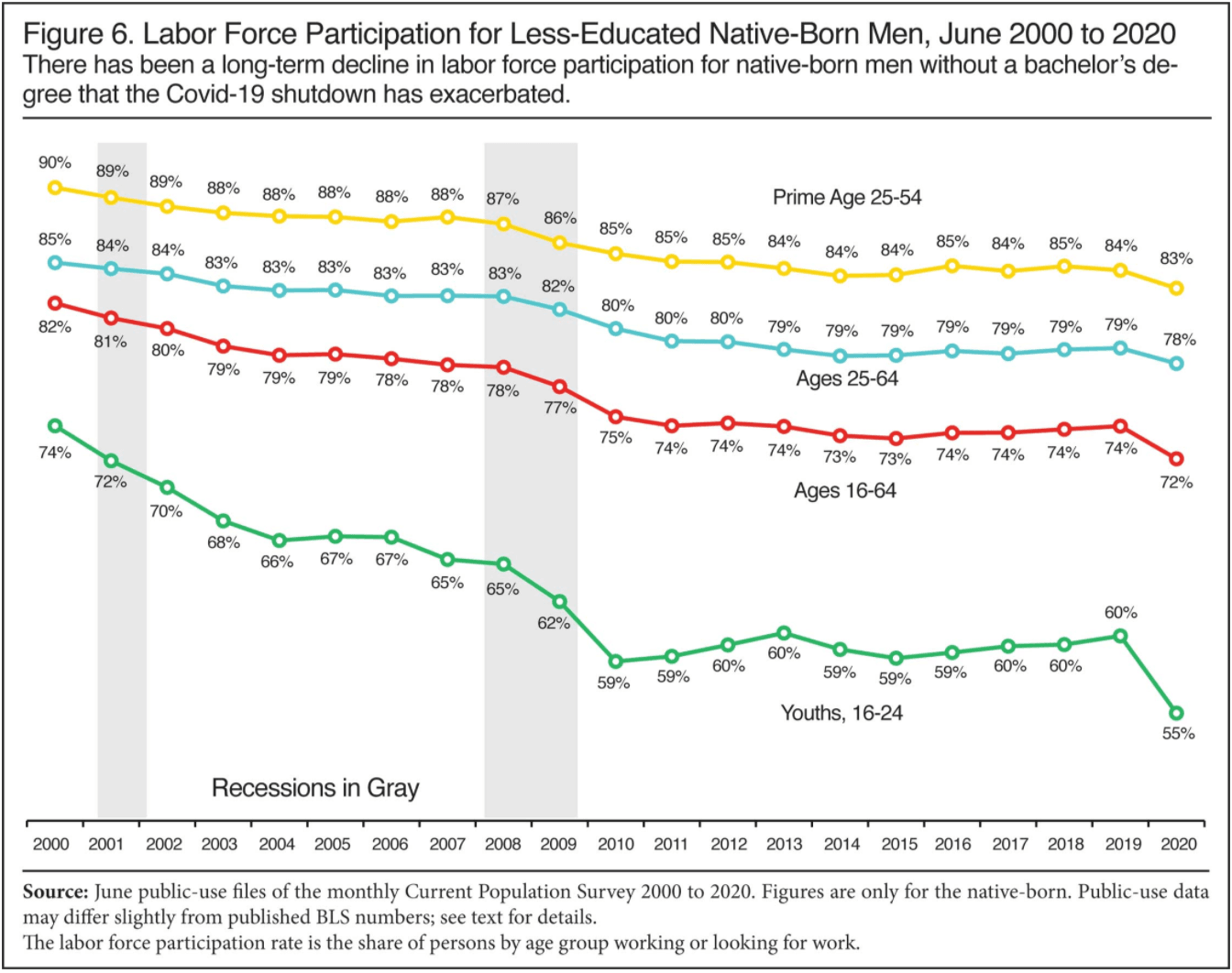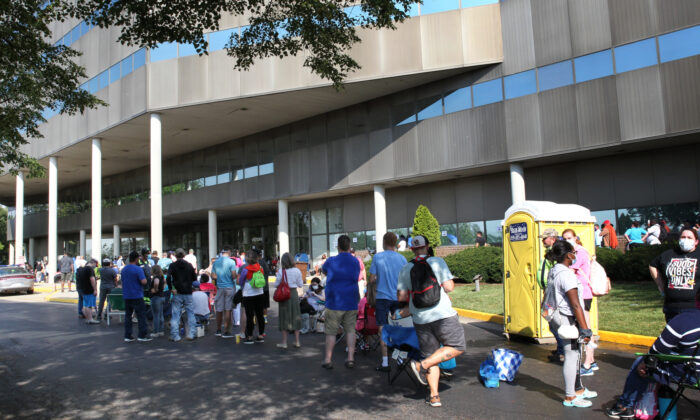THE CHAMBER HAS ALWAYS FOUGHT HARD FOR OPEN BORDERS AND AGAINST E-VERIFY TO KEEP WAGES DEPRESSED.
“Specifically, we find that the average refugee will cost around $60,000 in net present value over his or her lifetime, with adult refugees costing upwards of $133,000. These costs are due mainly to the low levels of education possessed by refugees upon their arrival,” they added.
Blue Collar American Men Fall Out of Labor Force at Highest Rate in 20 Years

3:06
The labor force participation rate among working class, native-born American men has hit a 20-year low, research shows.
Center for Immigration Studies (CIS) researchers Steven A. Camarota, Jason Richwine, and Karen Zeigler reveal in newly released research that the labor force participation rate for native-born American men without a bachelor’s degree has continued to decline since at least the year 2000.
As of June 2020, only 83 percent of native-born American men between 25 to 54 without a bachelor’s degree were in the labor force — a decline of seven percent since June 2000.
Likewise, native-born American men between 16 to 64 without a bachelor’s degree have a labor force participation rate of just 72 percent as of June 2020. This indicates a ten percent drop since June 2000.
“The Covid-19 shutdown has exacerbated the long-term decline in the labor force participation rate … of the less-educated,” the CIS researchers note.
The most pronounced decline over the last two decades has been among native-born American men between 16 to 24 — those mostly competing for entry-level jobs.
In June 2000, about 74 percent of this group was in the labor force. Today, only 55 percent were in the labor force, indicating a nearly 20 percent decline over 20 years.
The employment data shows an American economy that is vastly split between working class and lower middle class Americans and upper-middle-class and wealthy professionals.
For instance, while the unemployment rate for native-born Americans 25 to 54 without a bachelor’s degree is nearly 11 percent, the unemployment rate for those with at least a bachelor’s degree is 6.6 percent.
The research comes as the Chamber of Commerce sues President Trump’s administration, claiming they have a right to import foreign workers to fill scarce American jobs while tens of millions are unemployed, underemployed, or out of the labor force entirely.
Last month, Trump expanded his executive order to halt the inflow of H-1B, H-4, H-2B, L-1, and J-1 foreign visa workers in order to reduce foreign competition and give U.S. job priority to unemployed Americans. The order, coupled with visa reforms, is expected to open up at least 600,000 U.S. jobs for Americans.
Every year, the U.S. admits about 1.2 million legal immigrants on green cards to permanently resettle in the country. In addition, another 1.4 million foreign workers are admitted every year to take American jobs. The nation’s mass legal immigration levels have aided in depressing the wages of mostly working and lower middle class Americans while shifting wealth to the wealthiest earners.
John Binder is a reporter for Breitbart News. Follow him on Twitter at @JxhnBinder.
Chamber of Commerce: ‘Critical’ for Wealthy to Import Foreign Au Pairs During Coronavirus Crisis

3:00
A lawsuit by the Chamber of Commerce against President Trump’s administration claims it is “critical” that wealthy households are able to import foreign au pairs during the Chinese coronavirus crisis.
This week, Chamber of Commerce CEO Thomas Donohue announced the group’s lawsuit against Trump’s expanded executive order, signed last month, which halts the H-1B, H-4, H-2B, L-1, and J-1 visa programs to reduce foreign competition against 35 million unemployed and underemployed Americans.
Specifically, the lawsuit claims the J-1 visa program — where mostly upper-middle-class to wealthy households are allowed to import foreign au pairs at below-market wages — is “critical” during the nation’s time of crisis.
The lawsuit states:
And the au pair program is principally used by families that would otherwise lack live-in childcare. That resource is especially critical now, with children forced to stay home by the pandemic rather than attend school in person: Without childcare, many parents will be unable to work, decreasing productivity and deepening the Nation’s economic issues. [Emphasis added]
Companies that facilitate the hiring of J-1 visa holders, such as Intrax, will suffer “direct and irreparable loss” if the courts do not overturn Trump’s order, the lawsuit claims.
“For operators of J-1 programs, the Proclamation is an existential crisis,” the lawsuit states. “Loss of these small companies will only exacerbate current unemployment rates.”
Trump’s decision to halt the inflow of foreign au pairs defied the State Department’s recent justification of the program. In a regulation issued last month, the agency defended the program’s below-market wage rates.
The regulation seeks to justify wealthy households importing foreign au pairs for less than $11,000 a year with a mandate that the au pair work for 45 hours every week. This equates to a wage rate of about $4.33 an hour.
Today, there are about 26 million Americans who are unemployed or out of the labor force – all of whom want full-time jobs. Another more than nine million Americans are underemployed and want full-time employment.
In 2018, the foreign au pair program delivered more than 20,600 young people to upper-middle-class and wealthy households in the U.S. Nearly 60 percent of all foreign au pairs go to households in California, New York, New Jersey, Virginia, Massachusetts, Maryland, and Illinois, where there is a concentration of wealth.
The lawsuit was filed in the U.S. District Court for the Northern District of California. The case number is 3:20-cv-04887.
John Binder is a reporter for Breitbart News. Follow him on Twitter at @JxhnBinder.
Hundreds of unemployed Kentucky residents wait in long lines outside the Kentucky Career Center for help with their unemployment claims in Frankfort, Ky., on June 19, 2020 (John Sommers II/Getty Images)
Another 1.4 Million US Workers Seek Jobless Benefits
✉
More than 1.4 million Americans applied for unemployment benefits last week, the first increase in this closely watched barometer of the labor market since it began falling from its end-of-March peak of nearly 7 million, suggesting the economic recovery has hit a rough patch and appears to be stalling.
The Labor Department’s weekly jobless claims report (pdf) released July 23 shows that 1.42 million American workers filed initial jobless claims for the week ending July 18. That’s up by 109,000 from an upwardly revised 1.31 million the prior week.
“The COVID-19 virus continues to impact the number of initial claims and insured unemployment,” the Labor Department said in the release, as cases of the respiratory illness have surged across the country.
Authorities in the hard-hit South and West regions have moved to shut businesses again or pause reopenings. Workers being sent back home again are joining a second wave of layoffs, triggered by lack of demand as the economy battles recession.
There are a total of 31.8 million American workers receiving unemployment benefits across all programs, the Labor Department figures show. In the comparable week in 2019, there were 1.7 million people claiming unemployment benefits in all programs.
Small-business hiring has slowed in states experiencing a COVID-19 resurgence, according to high-frequency labor market data from a recent report by scheduling firm Homebase.
“States like Arizona, Florida, and Texas have seen the number of hours worked decline since cases began to spike at the end of June,” wrote Ray Sandza, vice president of data and analytics at the company.
After cresting in mid-June, the measure of hours worked in Arizona, Florida, and Texas was around 17 percent higher than in Massachusetts, New Jersey, and New York, while now that difference appears to be around 2 to 3 percent.
“States hit hardest at the beginning of the pandemic, including Massachusetts, New Jersey, and New York, have steadily improved and, despite a deeper trough, are almost even with states that re-opened earlier and are now experiencing a second wave of cases,” Sandza wrote.
The Labor Department figures show that the biggest increases in initial claims for the week ending July 11 were in Florida (+65,890), Georgia (+33,292), California (+20,123), Washington (+16,116), and Indiana (+6,258). The largest decreases in the same period were in Maryland (-13,728), Texas (-11,583), New Jersey (-8,577), Michigan (-6,882), and Louisiana (-5,066).
Demand has been showing signs of picking up, with retail sales increasing strongly in May and June, supported by the government’s additional weekly $600 checks for the unemployed. Known as the Federal Pandemic Unemployment Compensation (FPUC) program, this is the additional federal benefit of $600 per week over and above regular and state unemployment insurance payments and other forms of pandemic unemployment assistance.
Established by the $2.2 trillion CARES Act, the FPUC benefit is set to expire by July 31.
Negotiations are underway on Capitol Hill for some form of extension of the FPUC benefit, with Republicans considering a short-term extension, while Democrats are pushing for it to continue through January 2021.


No comments:
Post a Comment